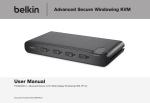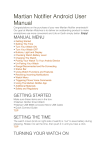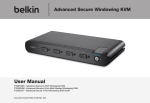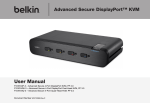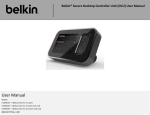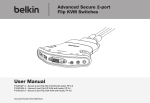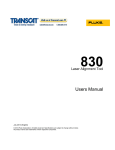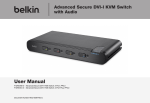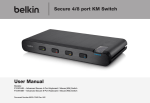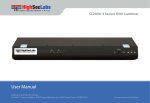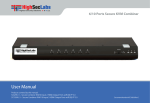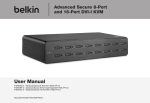Download User Manual - Belkin Business
Transcript
Advanced Secure Windowing KVM
User Manual
F1DN204M-3 – Advanced Secure 4-Port Multi-Display Windowing KVM, PP PSS 3.0
Document Number HDC10388 Rev.D
Installation
Table of Contents
SECTIONS
1
2
3
4
5
6
Notes about display resolution settings:
After Installation Checklist
-- The Belkin Advanced Secure Windowing KVM channel resolution,
selected from the channel menu, determines the size of the channel
window. It will not affect the actual resolution projected by the
connected computer.
Once required settings are set, check the final device product
configuration with all connected computers operating:
-- The Belkin Advanced Secure Windowing KVM is capable of scaling
the image in two possible factors: 2x and 4x allowing the user to fit
more information on the same display size.
2. Check that each window is coupled to the proper keyboard and
mouse (no cables are crossed between channels).
1. Check that each window is connected to the proper PC and has the
required border color.
3. Check that each window is coupled to the proper CAC input
(if applicable).
-- Selection of resolution higher or lower than resolution range of
connected display may result in image loss! In this case, you can
change the display to a different type or restore factory defaults.
4. Check that each window is coupled to the proper audio output (if
applicable).
-- To restore factory default settings, use a paper clip or another sharp
object and momentarily press the recessed RFD switch located at
the rear side above the DC power jack.
5. Check that all video cable thumb screws are secured.
-- See table in "Specifications" on page 14 for supported output
resolutions per model.
Belkin® Advanced Secure Windowing KVM User Manual
24
Installation
SECTIONS
Table of Contents
1
2
3
4
5
6
Dual display installation
Installation of dual display Multi-Viewer is similar to a single display with
the following changes:
2. It is recommended that both displays will be identical type and model.
1. Displays must be either 1920 x 1080 or 1920 x 1200 native resolution.
Do not use higher resolution as the image will be shown as a smaller
window or will be rescaled (resulting a degradation in the displayed
video quality).
4. Left side display must be connected to the primary console display
output jack (the right side jack when looking from the rear).
3. Displays should be oriented in landscape.
5. Conversion to VGA monitor is not supported.
Primary Display
Secondary Display
Channel 2
Channel 3
Channel 1
Channel 4
Setup
Channel 1
Channel 2
Channel 3 Channel 4
1
2
3
?
Scale
Tile
F1DN204M-3 scale mode view
Belkin® Advanced Secure Windowing KVM User Manual
25
Operation
Table of Contents
SECTIONS
1
2
3
4
5
6
Operation
Self-Test Procedure
Front Panel Push-Buttons
As product powers-up it performs a self-test procedure. In case of
self- test failure for any reason, including jammed buttons, the product
will be Inoperable. Self-test failure will be indicated by the following
abnormal LED behavior:
Following power up, the default channel is #1.
The user can select any other channel by pressing the appropriate front
panel push button.
The mouse cursor will be positioned at the center of the selected
• All channel-select LEDs will be turned ON and then OFF;
• A specific, predefined LED combination will be turned ON;
The currently selected channel is indicated by white color illumination of
the appropriate push-button.
• The predefined LED combination will indicate the problem type
(jammed buttons, firmware integrity).
Once a different channel is selected – video, keyboard, mouse, audio
follow selected channel. CAC behavior is described above.
Try to power cycle product. If problem persists please contact your
system administrator or technical support.
Notes:
1. Keyboard shortcut keys are to be pressed sequentially
2. CTRL key refers to LEFT CTRL key.
Now that product, computers and peripherals are connected and
powered up, it is ready for use.
Default Channel
~
`
After product boots up, the default active channel will be channel #1.
This will be indicated by white color illumination of push-button #1.
Tab
Caps
Shift
Product Mapping to Sources
Ctrl
Product mapping to sources is indicated by stickers/labels specifying
which channel is mapped to which computer.
Belkin® Advanced Secure Windowing KVM User Manual
26
Ctrl
!
1
@
2
#
3
$
4
Q W E
A
S
Z
D
X
Alt
%
5
R
F
C
^
6
T
&
7
Y
G H
V
B
(
9
*
8
U
J
N M
I
K
<
,
_
-
)
0
O
P
L
:
;
>
.
{
[
?
/
Alt
+
Delete
=
|
}
\
]
“
Enter
‘
Insert Home
Page
UP
Num
Lock
=
/
Delete
Page
Down
7
8
9
-
4
5
6
+
2
3
End
Shift
é
Ctrl
ç ê è
1
*
Enter
0
,
Operation
Table of Contents
SECTIONS
1
2
3
4
5
6
Operating Modes
Now that you have connected your console and computers to the Belkin
Advanced Secure Windowing KVM, it is ready for use. Default channel
after power up is channel #1 as indicated by channel select LED #1
illumination. The device is controllled using the 5-button mouse and
display interaction.
The use of 5-button mouse enables the user to fully use all standard
wheel mouse buttons for application-specific tasks and still operate The
Belkin Advanced Secure Windowing KVM specific functions using the
two extra side buttons.
The user may easily toggle between Normal and System Mode by
pressing one of the +/- side buttons.
User Mode
System Mode
Wheel Push =
Nothing
Wheel Push =
Application Specific
Wheel Rotate =
Cyclic togging between
windows
Wheel Rotate =
Application Specific
+ Key =
Switch to User Mode
+ Key =
Switch to System Mode
Left Key =
Move window while pressing,
brings window to front
Left Key =
Application Specific
- Key =
Switch to User Mode
- Key =
Switch to System Mode
Right Key =
Change window size (moves
bottom right corner)
Right Key =
Application Specific
Belkin® Advanced Secure Windowing KVM User Manual
27
Operation
Table of Contents
SECTIONS
1
2
3
4
5
6
List of Available Actions
KVM Combiner in User mode can be controlled via touch screen, mouse
clicks and keyboard shortcuts.
Action
Touch screen
Define Custom Presets
in System mode
N/A
Toggle between System
Mode and User Mode
Hold uppermost right corner of display for 4
seconds
Move between sources
(1 to 4) – change active
pane
Note: sources can also
be switched by using the
Combiner front panel
push buttons
Move to Tile
Keyboard
CTRL, CTRL, F1-F4
Note: CTRL, CTRL, F4 sets the custom
preset for Tile mode.
CTRL, CTRL, Q will always show the default
Tile mode with 4 equally sized panes in
display
Move to System mode:
CTRL, CTRL, O ,
Move to User mode:
CTRL, CTRL, U
N/A
Press Side Mouse Button
In System mode select
1-4 buttons in bottom grey
menu
Tap pane to select and interact with a specific
pane
CTRL, CTRL, Channel # (1-4)
In Scale mode Tap any of the small panes on
the right to make them primary
In User mode press on any
of the panes
In Tile mode use Scroll
Wheel Mouse button
In Scale mode click 4 times on primary pane to
move to Tile mode
Belkin® Advanced Secure Windowing KVM User Manual
Mouse
CTRL, CTRL, Q
28
In System mode Select Tile
button in bottom grey menu
Operation
Table of Contents
SECTIONS
1
2
3
4
5
6
Action
Touch screen
Keyboard
Mouse
Move to Scale
In Tile mode hold lower right corner of display
for 4 seconds to move to Scale mode
CTRL, CTRL, S
In System mode Select
Scale button in bottom grey
menu
Scale panes
Touch the midpoint of the vertical or horizontal
pane borders and hold while scaling. The
window and the content will resize.
Move/drag panes
In Tile mode touch the upper left corner of a
specific pane to move it
Resize pane
Enlarge pane to full
screen
Connecting Secondary
Display in Duplicate
Mode
CTRL, CTRL, ”-“ : Reduce Scaling
CTRL, CTRL, ”+” : Increase Scaling
Press and hold Side mouse
button + Scroll wheel to
reduce/increase scaling.
For Fast scaling use mouse
Side button & Scroll wheel
while holding pressed Left
CTRL button
N/A
Left-Click Mouse button
In Tile mode touch the lower right corner of a
specific pane to resize window without fitting
the content. To fit content use CTRL, CTRL, W
CTRL, CTRL, W: Fit the desktop to the
resized pane
Press and hold Right-Click
Mouse button to resize
pane. Maybe only part of the
desktop will be displayed
(see mouse actions for
further resize options).
In Tile mode tap 4 times on pane to move to Full
screen mode
CTRL, CTRL, F: Full Screen
CTRL, CTRL, Z: Goes back to last layout
before enlarging pane to Full Screen
In Full screen mode tap 4 times to move to Tile
mode
CTRL, CTRL, F11, L
N/A
Belkin® Advanced Secure Windowing KVM User Manual
29
Double Left-Click Mouse
button in System mode
N/A
Operation
Table of Contents
SECTIONS
Action
1
2
3
Touch screen
4
5
Keyboard
6
Mouse
CTRL, CTRL, F11, J, J – Primary display is
presented on both displays
CTRL, CTRL, F11, K, K - Secondary display
is presented on both displays
Controlling Content
and Order of Displays in
Extend Mode
CTRL, CTRL, F11, K, J – Switch positions
between Primary and Secondary displays.
N/A
CTRL, CTRL, F11, J, K - Switch positions
back between Primary and Secondary
displays.
N/A
Note:
J stands for Primary display.
K stands for Secondary display.
CTRL, CTRL, P to enter mode
Presentation Mode
-define a channel that
will always appear
in Full Screen once
selected
CTRL, CTRL, X (X=Channel # 1-4), for
example channel #1. Channel 1 will be
displayed in full screen
N/A
CTRL, CTRL, Channel # other than X, e.g.
channel #2, will move back to Tile Mode
N/A
CTRL, CTRL, N To move out of Presentation
Mode
Operate applications in
a specific active pane in
User mode
Normal touch screen behavior
Belkin® Advanced Secure Windowing KVM User Manual
Normal keyboard behavior
30
Normal mouse behavior
Operation
Table of Contents
SECTIONS
1
2
3
4
5
6
User Mode
The Belkin Advanced Secure Windowing KVM enables simultaneous
interaction with 4 different computers using a single or dual display,
keyboard and mouse. When the user interacts with an application at
a specific window, that channel is active and the mouse and keyboard
are affecting only that channel. The top left corner of the active channel
window is white as an indication. In User Mode there is always one
channel which is considered to be active. Mouse, keyboard and audio
are mapped to the active channel.
• All mouse buttons (and wheel) will function based on the
computer-assigned specific role (not affected by the KVM) (the
mouse side buttons are used to exit User Mode and switch to
System Mode).
The user may move to a different channel by:
• The task-bar is not shown on user display, buttons are not
accessible.
• Keyboard is mapped to the active window computer.
• Audio output will only be heard from the active computer.
• The active window will always be on top of all other windows.
1. Switching first to System Mode. While in System Mode, the cursor
will change to the selected System Mode cursor and will enable free
movement throughout the display area. Once in System Mode the
user may point at another window and use the +/- to make it active.
• Pressing + / - (on the side of the mouse) mouse buttons will toggle
the Belkin Secure KVM to system mode.
• When using a PS/2 (which does not have the side buttons)
pressing both right and left buttons at the same time will also
toggle the KVM to system mode.
2. Using front-panel push buttons to select a different channel.
When the Belkin Advanced Secure Windowing KVM is in User Mode:
System Mode
• The mouse cursor of the active computer (channel) is controlled
by the console mouse.
The mouse +/- side buttons trigger cyclic toggling between modes.
System mode can be easily identified by the appearance of the title bar/
task-bar at the bottom of the display.
• The mouse cursor symbol is generated/controlled by the
computer operating system/application.
The Belkin Advanced Secure Windowing KVM System Mode enables
the user to manage his/her combined desktop and customize it for
the job being done. This mode also enables the user to move between
windows and to minimize/maximize windows as needed.
• Mouse movement is limited to the active window area.
Belkin® Advanced Secure Windowing KVM User Manual
31
Operation
Table of Contents
SECTIONS
1
2
3
In System Mode there is also an active channel, indicated by a white top
left corner but the mouse is controlled by the Belkin Advanced Secure
Windowing KVM and not mapped to the active channel.
5
6
resolution is larger than the window size).
• Pressing and holding the +/- side mouse buttons and moving the
mouse wheel will rescale the window (change the size of the input
picture). This will be further explained in the scaling part of this
manual.
When the Belkin Advanced Secure Windowing KVM is in System Mode:
• The mouse cursor is controlled by the system mouse.
• The mouse cursor is generated/controlled by the Windowing KVM.
• Mouse movement is unlimited in all display areas.
• The keyboard is routed to the active window (active window is
always in front).
• Audio output is switched from the active window PC.
• Task-bar visible and buttons are accessible.
• Pressing + / - mouse buttons will change to User Mode and the
active window will be the window where the system cursor was
last positioned.
• Left-clicking on a window will bring it to the front and make it the
active window.
Change of Active Window
When in System Mode there is always one window, which is considered
the active window. The active window’s top left corner will be marked
in white (as opposed to black in all other windows) and its icon on the
task-bar will show as pressed.
The active window is the window to which the keyboard, audio and CAC
device are mapped. In User Mode the mouse will also be mapped to
this window.
Switching between active windows (when in System Mode) is simply
done by right-clicking on another window with the mouse cursor.
Another option to switch between active windows in System Mode is
by using the mouse wheel. Windows will move to the front at a cyclic
sequence.
Pressing the left mouse button and holding it, will drag the window
under it.
• Double-clicking on a window will maximize that window to full
screen.
• Right-clicking on the bottom right corner of a window and
dragging will allow changing the window size (limited by the size
set under the channel menu).
• Pressing both right and left keys on an active window will allow
moving the picture inside the window (only applicable if the source
Belkin® Advanced Secure Windowing KVM User Manual
4
Moving Between Windows in User Mode
When in User Mode, moving between windows can be done either
by switching to System Mode (by pressing the mouse side buttons),
pointing at the new window and switching back to User Mode (by
pressing the mouse side buttons again). Another option is to use the
front-panel push buttons.
32
Operation
Table of Contents
SECTIONS
1
2
3
4
5
6
Functions and Features
Dragging a Window
Window Internal Scroll
In order to move a window, user should first switch to System Mode
by pressing + or – mouse side buttons. In System Mode, hold the left
mouse button when the system cursor located on the desired window
and the window will move. Release left mouse button to drop window
in place.
When window size is smaller than input image size, it might be required
to “move” the image inside the window. This is done by pointing at the
window, pressing both mouse buttons at the same time and moving the
mouse. Release the mouse buttons to freeze the position of the window.
Notes: Window movement to the left side is limited by the display
boundary.
The “?” button located at the task-bar (see figure below) show mouse
functionality bitmap with mouse functions.
Help button
Window movement to the right side is unlimited (window may be pushed
out of the display viewable area).
Setup
Channel 1
Channel 2
Channel 3 Channel 4
1
2
3
?
Scale
Tile
Window Resizing
In order to resize a window, the user should first switch to System Mode
by pressing + or – mouse side buttons. In System Mode, the user should
drag the mouse while holding the right mouse button when the system
cursor is located on the bottom right corner of the desired window.
Release right mouse button to freeze window size.
Move
Resize
Toggle
Mode
Note: Window size is limited by the size set for the window under the
channel menu.
L: Move Window
R: Resize Window
L + R: Pan
Belkin® Advanced Secure Windowing KVM User Manual
33
Operation
Table of Contents
SECTIONS
1
2
3
Maximizing a window to full-screen mode
4
5
6
Note: When the Belkin Advanced Secure Windowing KVM maximizes
a window it will change output display resolution to the input
resolution. The reaction of this change on the display may change
according to the display design. Some displays may automatically
adjust to new resolution and rescale (showing full image), while others
may not and will show black borders around the image.
To maximize a window to its full size, enter System Mode by pressing +
or – mouse side buttons, bringing the system cursor to the window that
should be maximized, and then double-clicking on that window.
The selected window will maximize to its native input resolution. No
other windows or bars will be displayed.
To leave maximize mode, change back to System Mode (by pressing the
mouse side buttons) and rearrange windows as needed.
Note: Maximizing a window to full-screen mode in the 204M is
slightly different than other models. See detailed explanation below.
Note: When using the Belkin Advanced Secure Windowing KVM, it
is possible to maximize a window directly from User Mode. Pressing
CTRL, CTRL, f will maximize the window in which the user is working.
Note:
For tile mode press CTRL, CTRL, q
For scale mode press CTRL, CTRL, s
For system mode press CTRL, CTRL, o
For User Mode press CTRL, CTRL, u
Belkin® Advanced Secure Windowing KVM User Manual
34
Operation
Table of Contents
SECTIONS
1
2
3
Deactivating/Activating channels
The user can remove inactive channels. In order to deactivate a channel
the user should enter System Mode and then move the system cursor
to the desired channel button at the task-bar and double-click on it. A
red X should appear on that channel (see figure below).
In some cases the user may want to deactivate a live channel for
operational reasons. The Belkin Advanced Secure Windowing KVM will
display instead on that channel a background color.
Setup
Channel 1
Channel 2
Channel 3 Channel 4
5
6
Dual-display operation
Maximizing a window
When in System Mode, double-clicking on a window will maximize that
window to full screen. If the window is shown on both displays, it will
maximize at the display where a larger portion of that window is lying.
For example: if 60 percent of the window is at the primary display, it will
maximize at the primary. When it is maximizing, the other 40 percent
of that window will disappear from the secondary display. The second
monitor will still display the same windows as before accessing the fullscreen mode. Any other windows on the display to which the window
1was2 maximized
3
? will be hidden
Scale behind the
Tile
maximized window.
In dual-display mode, the tile function will place channels 1 and 3
windows on the primary display and channels 2 and 4 windows at the
secondary display.
In this example, channel #1 was deactivated.
Repeating this process will cancel this status and reactivate that
channel.
Once a channel had been deactivated, it would not participate in cyclic
toggling between windows and will not be displayed in any way.
Belkin® Advanced Secure Windowing KVM User Manual
4
35
Operation
Table of Contents
SECTIONS
1
2
3
4
5
6
Scale Feature
The Belkin Advanced Secure Windowing KVM includes a scaling
function. The scaling function allows the user to reduce the size of the
source image without losing information, enabling him to see more of
the sources on limited screen space. Scaling is done by an advanced
scaling algorithm developed by Belkin.
By pressing the Scale button on the System Mode task-bar, the screen
will be rearranged as follow:
Tile Feature
Channel 2
The tile feature is accessed from System Mode by clicking on the
Tile button located on the task-bar. By pressing Tile the windows be
arranged in tile mode but will automatically be scaled by 1:2x factor.
For example, if the input source resolution is 1920x1080, the image
displayed in the source window will be 960x540. The size of the window
is, as always, determined by the output resolution (will be a quarter of
the available screen area). Tile is actually a preset of System Mode and,
once in tile mode, all System Mode functions are available.
Channel 1
Not Scaled
Channel 3
1:4 Scaled
Channel 4
Setup
Channel 1
Channel 2
Channel 3 Channel 4
1
2
3
?
Scale
Tile
Scale a specific window
From System Mode it is possible to scale a specific window simply by
pointing on the active window, pressing the mouse side buttons and
moving the mouse wheel.
User display on the Windowing KVM in Scale mode
The active window centered (not scaled) and the other windows will
move to the right side and scaled 1:4 times.
This will toggle the scaling of the active window between 1:2 times, 1:4
times and no scaling, keeping the actual window frame size fixed.
It is still possible in this mode to use all standard System Mode functions
to switch active between windows.
It is also possible to scale a window (both from System and User Modes
by using the CTRL, CTRL, +/- key combination where pressing + will
reduce the scaling (from 1:4X to 1:2X and from 1:2X to no scaling) and
the – will increase the scaling (from no scaling to 1:2X and from 1:2X
to 1:4X).
Belkin® Advanced Secure Windowing KVM User Manual
Also, once in scale mode moving the mouse wheel will toggle between
windows making a different source the central display.
Using the front-panel push buttons will change the active window
without repositioning the windows.
36
Troubleshooting
Table of Contents
SECTIONS
1
2
3
4
5
6
General
As product powers-up all channel-select LEDs are turned ON and
then OFF. After that a specific, predefined LED combination is
turned ON. Product is inoperable.
Channel select LEDs are blinking. Belkin Advanced Secure
Windowing KVM does not work.
• Device anti-tampering system was triggered. Change unit and call
Belkin technical support.
• The product did not pass self-test procedure. Try to power
cycle product. If problem persists please contact your system
administrator or our technical support.
Preset buttons are erased (empty).
• Normal behavior if KVM entered into system setting mode.
No power. No video output, none of the front-panel LEDs are
illuminating.
Video
• Check that the power supply is properly connected to the mains
socket.
No video image in user display (all channels)
• Check that the DC plug is fully inserted into the KVM DC jack.
• Check that the display is properly powered.
• Check that the connected power supply is the proper one
(12V/5A). Do not use power supply from another vendor!
• Check that DVI cable is properly secured at both sides.
• Check at the display on-screen menu that source selected is DVI
• Check that the device is powered-on by using an optical mouse
with visible red light. If power is not available, change the power
supply.
• Check if PC video output mode is DVI.
• Connect the display directly to the PC to confirm that video output
is available and that good image is shown.
How do I restore the factory settings of the Belkin Advanced
Secure Windowing KVM?
• Restore to factory defaults using the rear-panel recessed switch
(see item 16 in the figure at page 11 above).
• It is possible to restore the device to its original factory settings
through the use of the Restore Factory Defaults switch (see image
17 on page 12). Pressing this switch for 2–3 seconds will return the
KVM to the original production settings including lowest output
resolution.
Belkin® Advanced Secure Windowing KVM User Manual
37
Troubleshooting
Table of Contents
SECTIONS
1
2
3
No video image in user display (specific channel only).
4
5
6
Window showing background color (no image inside).
• Reboot the computer.
• Check that the channel is not deactivated by user.
• Check that the video cable connecting the computer and KVM is
properly secured at both sides.
• Check that video cable is connected properly between The Belkin
Advanced Secure Windowing KVM and the attached computer.
• Check that the PC video output is sent to the connected video
connector (if PC supports multiple displays).
• Check that the connected computer is powered on/not in display
power-saving mode.
• Check that the PC resolution matches connected display
capabilities.
• Connect the display directly to that computer to verify that proper
video output is available.
• Connect the display directly to the PC to confirm that the video
output is available and that a good image is shown.
Bad video image quality (some or all channels).
• Check that all video cables are inserted properly to the KVM,
computer, and display.
Window showing smaller image with black borders or bad image.
Belkin Secure Windowing KVM channel was connected to a source that
is set to a lower resolution than the KVM setting for that channel.
• Check that cables are original cables supplied by Belkin.
• Adjust source (PC) resolution to match Windowing KVM channel
resolution.
• With everything connected, power-cycle the Windowing KVM
to reset the video. Make sure the Video Diagnostic LED is solid
green.
• Change channel input resolution in KVM to lower resolution using
system mode.
• Check that the display that you are using supports the resolution
and refresh-rate setting on your computer.
• Lower the video resolution of your PCs.
• Check that the video-cable length does not exceed 4.6m (15 feet).
• Connect the display directly into the computer with which you are
having trouble to see if the problem still appears.
Belkin® Advanced Secure Windowing KVM User Manual
38
Troubleshooting
Table of Contents
SECTIONS
1
2
3
4
5
6
Keyboard
Keyboard and mouse are not working (two channels).
Keyboard Caps Lock and Num Lock LEDs are not working.
• Check that computer USB and video cables are not crossed (i.e.,
computer #1 video is connected to KVM port #1 while USB cable
is connected to the KVM port #2).
• This is a normal behavior. Belkin Secure Windowing KVM blocks
all communications from computers to the keyboard to prevent
certain potential data leakages.
Keyboard does not work (all channels).
Certain keyboard functions are not working.
• Check that the keyboard you are using is connected properly to
the KVM.
• Some non-standard keyboard functions are disabled by the
KVM to prevent security risks. Contact Belkin support for latest
compatibility list.
• Check that the USB cable between the KVM and the computer is
completely connected.
• Try connecting to a different USB port on the computer.
• Make sure the keyboard works when directly plugged into the
computer (the HID USB driver is installed on the computer).
• Rebooting may be necessary when trying this.
• Make sure you are not using a wireless keyboard or a keyboard
with an integrated USB hub or other USB-integrated devices.
These are not supported by the KVM due to security policy.
• If the computer is coming out of standby mode, allow up to one
minute to regain mouse function.
• Try a different keyboard.
Belkin® Advanced Secure Windowing KVM User Manual
39
Troubleshooting
Table of Contents
SECTIONS
1
2
3
Mouse
Mouse and keyboard are not working (two channels).
• Check that computer USB and video cables are not crossed (i.e.,
computer #1 video connected to KVM port #1 while USB cable is
connected to KVM port #2).
Mouse does not work (all channels).
• Check that the mouse you are using is connected properly to the
KVM.
• Check that the USB cable between the KVM and the computer is
completely connected.
• Try connecting to a different USB port on the computer.
• Make sure the mouse works when directly plugged into the
computer (the HID USB driver is installed on the computer).
• Rebooting may be necessary when trying this.
• Make sure you are not using a wireless mouse or a mouse with an
integrated USB hub or other USB-integrated devices. These are
not supported by the KVM due to security policy.
• If the computer is coming out of standby mode, allow up to one
minute to regain mouse function.
• Try a different mouse.
Belkin® Advanced Secure Windowing KVM User Manual
40
4
5
6
Information
Table of Contents
SECTIONS
1
2
3
4
5
6
FCC Statement
Warranty
DE C LARAT I ON OF C ONFOR M I T Y W I T H FC C RULES FOR
ELECTROMAGNETIC COMPATIBILITY
Belkin International, Inc., Limited 3-Year Product Warranty
What this warranty covers.
We, Belkin International, Inc., of 12045 E. Waterfront Drive, Playa
Vista, CA 90094, declare under our sole responsibility that the
products comply with Part 15 of the FCC Rules. Operation is subject
to the following two conditions: (1) this device may not cause harmful
interference, and (2) this device must accept any interference received,
including interference that may cause undesired operation.
Belkin International, Inc. (“Belkin”) warrants to the original purchaser of
this Belkin product that the product shall be free of defects in design,
assembly, material, or workmanship.
What the period of coverage is?
Belkin warrants the Belkin product for three years.
CE Declaration of Conformity
What will we do to correct problems?
We, Belkin International, Inc., declare under our sole responsibility that
the products are in conformity with Emissions Standard EN55022 and
with Immunity Standard EN55024, LVP EN61000-3-2, and EN61000-3-3.
Product Warranty.
Belkin will repair or replace, at its option, any defective product free of
charge (except for shipping charges for the product). Belkin reserves
the right to discontinue any of its products without notice, and disclaims
any limited warranty to repair or replace any such discontinued
products. In the event that Belkin is unable to repair or replace the
product (for example, because it has been discontinued), Belkin will
offer either a refund or a credit toward the purchase of another product
from Belkin.com in an amount equal to the purchase price of the
product as evidenced on the original purchase receipt as discounted
by its natural use.
ICES
This Class B digital apparatus complies with Canadian ICES-003. Cet
appareil numérique de la classe B est conforme á la norme NMB-003
du Canada.
Belkin® Advanced Secure Windowing KVM User Manual
41
Information
Table of Contents
SECTIONS
1
2
3
4
5
6
What is not covered by this warranty?
All above warranties are null and void if the Belkin product is not
provided to Belkin for inspection upon Belkin’s request at the sole
expense of the purchaser, or if Belkin determines that the Belkin
product has been improperly installed, altered in any way, or tampered
with. The Belkin Product Warranty does not protect against acts of God
such as flood, lightning, earthquake, war, vandalism, theft, normal-use
wear and tear, erosion, depletion, obsolescence, abuse, damage due
to low voltage disturbances (i.e. brownouts or sags), non-authorized
program, or system equipment modification or alteration.
Belkin reserves the right to review the damaged Belkin product. All costs
of shipping the Belkin product to Belkin for inspection shall be borne
solely by the purchaser. If Belkin determines, in its sole discretion, that
it is impractical to ship the damaged equipment to Belkin, Belkin may
designate, in its sole discretion, an equipment repair facility to inspect
and estimate the cost to repair such equipment. The cost, if any, of
shipping the equipment to and from such repair facility and of such
estimate shall be borne solely by the purchaser. Damaged equipment
must remain available for inspection until the claim is finalized.
Whenever claims are settled, Belkin reserves the right to be subrogated
under any existing insurance policies the purchaser may have.
How to get service
To get service for your Belkin product you must take the following steps:
1. Contact Belkin International, Inc., at 12045 E. Waterfront Drive,
Playa Vista, CA 90094, Attn: Customer Service, or call toll-free
(800)-282-2355, within 15 days of the Occurrence. Be prepared to
provide the following information:
a. The part number of the Belkin product.
b. Where you purchased the product.
c. When you purchased the product.
d. Copy of original receipt.
2. Your Belkin Customer Service Representative will then instruct
you on how to forward your receipt and Belkin product and how to
proceed with your claim.
Belkin® Advanced Secure Windowing KVM User Manual
42
Information
Table of Contents
SECTIONS
1
2
3
How state law relates to the warranty.
THIS WARRANTY CONTAINS THE SOLE WARRANTY OF BELKIN.
THERE ARE NO OTHER WARRANTIES, EXPRESSED OR, EXCEPT AS
REQUIRED BY LAW, IMPLIED, INCLUDING THE IMPLIED WARRANTY
OR CONDITION OF QUALITY, MERCHANTABILITY OR FITNESS FOR A
PARTICULAR PURPOSE, AND SUCH IMPLIED WARRANTIES, IF ANY,
ARE LIMITED IN DURATION TO THE TERM OF THIS WARRANTY.
Some states do not allow limitations on how long an implied warranty
lasts, so the above limitations may not apply to you.
IN NO EVENT SHALL BELKIN BE LIABLE FOR INCIDENTAL, SPECIAL,
DIRECT, INDIRECT, CONSEQUENTIAL OR MULTIPLE DAMAGES SUCH
AS, BUT NOT LIMITED TO, LOST BUSINESS OR PROFITS ARISING
OUT OF THE SALE OR USE OF ANY BELKIN PRODUCT, EVEN IF
ADVISED OF THE POSSIBILITY OF SUCH DAMAGES.
This warranty gives you specific legal rights, and you may also have
other rights, which may vary from state to state. Some states do not
allow the exclusion or limitation of incidental, consequential, or other
damages, so the above limitations may not apply to you.
Belkin® Advanced Secure Windowing KVM User Manual
43
4
5
6
Information
Table of Contents
SECTIONS
1
2
3
Reporting Belkin Product Security Vulnerability.
If you are aware of potential security vulnerability with any Belkin
Government product, we encourage you to contact us immediately
at the following email address: [email protected] or our
technical support line at: TOLL FREE 1-800-282-2355
After your communication is received, Belkin Government personnel will
contact you to follow up. To ensure confidentiality, Belkin encourages
you to use our PGP encryption key.
The [email protected] email address is not intended to reach
technical support on Belkin Government products or services.
Belkin® Advanced Secure Windowing KVM User Manual
44
4
5
6
belkinbusiness.com
© 2015 Belkin International, Inc. All rights reserved. All trade names are registered trademarks of respective manufacturers
listed. Windows and Windows Vista are either registered trademarks or trademarks of Microsoft Corporation in the United
States and/or other countries. Mac OS is a trademark of Apple Inc., registered in the U.S. and other countries.
Installation
Table of Contents
SECTIONS
1
2
3
4
5
6
Notes about display resolution settings:
After Installation Checklist
-- The Belkin Advanced Secure Windowing KVM channel resolution,
selected from the channel menu, determines the size of the channel
window. It will not affect the actual resolution projected by the
connected computer.
Once required settings are set, check the final device product
configuration with all connected computers operating:
-- The Belkin Advanced Secure Windowing KVM is capable of scaling
the image in two possible factors: 2x and 4x allowing the user to fit
more information on the same display size.
2. Check that each window is coupled to the proper keyboard and
mouse (no cables are crossed between channels).
1. Check that each window is connected to the proper PC and has the
required border color.
3. Check that each window is coupled to the proper CAC input
(if applicable).
-- Selection of resolution higher or lower than resolution range of
connected display may result in image loss! In this case, you can
change the display to a different type or restore factory defaults.
4. Check that each window is coupled to the proper audio output (if
applicable).
-- To restore factory default settings, use a paper clip or another sharp
object and momentarily press the recessed RFD switch located at
the rear side above the DC power jack.
5. Check that all video cable thumb screws are secured.
-- See table in "Specifications" on page 14 for supported output
resolutions per model.
Belkin® Advanced Secure Windowing KVM User Manual
24
Installation
SECTIONS
Table of Contents
1
2
3
4
5
6
Dual display installation
Installation of dual display Multi-Viewer is similar to a single display with
the following changes:
2. It is recommended that both displays will be identical type and model.
1. Displays must be either 1920 x 1080 or 1920 x 1200 native resolution.
Do not use higher resolution as the image will be shown as a smaller
window or will be rescaled (resulting a degradation in the displayed
video quality).
4. Left side display must be connected to the primary console display
output jack (the right side jack when looking from the rear).
3. Displays should be oriented in landscape.
5. Conversion to VGA monitor is not supported.
Primary Display
Secondary Display
Channel 2
Channel 3
Channel 1
Channel 4
Setup
Channel 1
Channel 2
Channel 3 Channel 4
1
2
3
?
Scale
Tile
F1DN204M-3 scale mode view
Belkin® Advanced Secure Windowing KVM User Manual
25
Operation
Table of Contents
SECTIONS
1
2
3
4
5
6
Operation
Self-Test Procedure
Front Panel Push-Buttons
As product powers-up it performs a self-test procedure. In case of
self- test failure for any reason, including jammed buttons, the product
will be Inoperable. Self-test failure will be indicated by the following
abnormal LED behavior:
Following power up, the default channel is #1.
The user can select any other channel by pressing the appropriate front
panel push button.
The mouse cursor will be positioned at the center of the selected
• All channel-select LEDs will be turned ON and then OFF;
• A specific, predefined LED combination will be turned ON;
The currently selected channel is indicated by white color illumination of
the appropriate push-button.
• The predefined LED combination will indicate the problem type
(jammed buttons, firmware integrity).
Once a different channel is selected – video, keyboard, mouse, audio
follow selected channel. CAC behavior is described above.
Try to power cycle product. If problem persists please contact your
system administrator or technical support.
Notes:
1. Keyboard shortcut keys are to be pressed sequentially
2. CTRL key refers to LEFT CTRL key.
Now that product, computers and peripherals are connected and
powered up, it is ready for use.
Default Channel
~
`
After product boots up, the default active channel will be channel #1.
This will be indicated by white color illumination of push-button #1.
Tab
Caps
Shift
Product Mapping to Sources
Ctrl
Product mapping to sources is indicated by stickers/labels specifying
which channel is mapped to which computer.
Belkin® Advanced Secure Windowing KVM User Manual
26
Ctrl
!
1
@
2
#
3
$
4
Q W E
A
S
Z
D
X
Alt
%
5
R
F
C
^
6
T
&
7
Y
G H
V
B
(
9
*
8
U
J
N M
I
K
<
,
_
-
)
0
O
P
L
:
;
>
.
{
[
?
/
Alt
+
Delete
=
|
}
\
]
“
Enter
‘
Insert Home
Page
UP
Num
Lock
=
/
Delete
Page
Down
7
8
9
-
4
5
6
+
2
3
End
Shift
é
Ctrl
ç ê è
1
*
Enter
0
,
Operation
Table of Contents
SECTIONS
1
2
3
4
5
6
Operating Modes
Now that you have connected your console and computers to the Belkin
Advanced Secure Windowing KVM, it is ready for use. Default channel
after power up is channel #1 as indicated by channel select LED #1
illumination. The device is controllled using the 5-button mouse and
display interaction.
The use of 5-button mouse enables the user to fully use all standard
wheel mouse buttons for application-specific tasks and still operate The
Belkin Advanced Secure Windowing KVM specific functions using the
two extra side buttons.
The user may easily toggle between Normal and System Mode by
pressing one of the +/- side buttons.
User Mode
System Mode
Wheel Push =
Nothing
Wheel Push =
Application Specific
Wheel Rotate =
Cyclic togging between
windows
Wheel Rotate =
Application Specific
+ Key =
Switch to User Mode
+ Key =
Switch to System Mode
Left Key =
Move window while pressing,
brings window to front
Left Key =
Application Specific
- Key =
Switch to User Mode
- Key =
Switch to System Mode
Right Key =
Change window size (moves
bottom right corner)
Right Key =
Application Specific
Belkin® Advanced Secure Windowing KVM User Manual
27
Operation
Table of Contents
SECTIONS
1
2
3
4
5
6
List of Available Actions
KVM Combiner in User mode can be controlled via touch screen, mouse
clicks and keyboard shortcuts.
Action
Touch screen
Define Custom Presets
in System mode
N/A
Toggle between System
Mode and User Mode
Hold uppermost right corner of display for 4
seconds
Move between sources
(1 to 4) – change active
pane
Note: sources can also
be switched by using the
Combiner front panel
push buttons
Move to Tile
Keyboard
CTRL, CTRL, F1-F4
Note: CTRL, CTRL, F4 sets the custom
preset for Tile mode.
CTRL, CTRL, Q will always show the default
Tile mode with 4 equally sized panes in
display
Move to System mode:
CTRL, CTRL, O ,
Move to User mode:
CTRL, CTRL, U
N/A
Press Side Mouse Button
In System mode select
1-4 buttons in bottom grey
menu
Tap pane to select and interact with a specific
pane
CTRL, CTRL, Channel # (1-4)
In Scale mode Tap any of the small panes on
the right to make them primary
In User mode press on any
of the panes
In Tile mode use Scroll
Wheel Mouse button
In Scale mode click 4 times on primary pane to
move to Tile mode
Belkin® Advanced Secure Windowing KVM User Manual
Mouse
CTRL, CTRL, Q
28
In System mode Select Tile
button in bottom grey menu
Operation
Table of Contents
SECTIONS
1
2
3
4
5
6
Action
Touch screen
Keyboard
Mouse
Move to Scale
In Tile mode hold lower right corner of display
for 4 seconds to move to Scale mode
CTRL, CTRL, S
In System mode Select
Scale button in bottom grey
menu
Scale panes
Touch the midpoint of the vertical or horizontal
pane borders and hold while scaling. The
window and the content will resize.
Move/drag panes
In Tile mode touch the upper left corner of a
specific pane to move it
Resize pane
Enlarge pane to full
screen
Connecting Secondary
Display in Duplicate
Mode
CTRL, CTRL, ”-“ : Reduce Scaling
CTRL, CTRL, ”+” : Increase Scaling
Press and hold Side mouse
button + Scroll wheel to
reduce/increase scaling.
For Fast scaling use mouse
Side button & Scroll wheel
while holding pressed Left
CTRL button
N/A
Left-Click Mouse button
In Tile mode touch the lower right corner of a
specific pane to resize window without fitting
the content. To fit content use CTRL, CTRL, W
CTRL, CTRL, W: Fit the desktop to the
resized pane
Press and hold Right-Click
Mouse button to resize
pane. Maybe only part of the
desktop will be displayed
(see mouse actions for
further resize options).
In Tile mode tap 4 times on pane to move to Full
screen mode
CTRL, CTRL, F: Full Screen
CTRL, CTRL, Z: Goes back to last layout
before enlarging pane to Full Screen
In Full screen mode tap 4 times to move to Tile
mode
CTRL, CTRL, F11, L
N/A
Belkin® Advanced Secure Windowing KVM User Manual
29
Double Left-Click Mouse
button in System mode
N/A
Operation
Table of Contents
SECTIONS
Action
1
2
3
Touch screen
4
5
Keyboard
6
Mouse
CTRL, CTRL, F11, J, J – Primary display is
presented on both displays
CTRL, CTRL, F11, K, K - Secondary display
is presented on both displays
Controlling Content
and Order of Displays in
Extend Mode
CTRL, CTRL, F11, K, J – Switch positions
between Primary and Secondary displays.
N/A
CTRL, CTRL, F11, J, K - Switch positions
back between Primary and Secondary
displays.
N/A
Note:
J stands for Primary display.
K stands for Secondary display.
CTRL, CTRL, P to enter mode
Presentation Mode
-define a channel that
will always appear
in Full Screen once
selected
CTRL, CTRL, X (X=Channel # 1-4), for
example channel #1. Channel 1 will be
displayed in full screen
N/A
CTRL, CTRL, Channel # other than X, e.g.
channel #2, will move back to Tile Mode
N/A
CTRL, CTRL, N To move out of Presentation
Mode
Operate applications in
a specific active pane in
User mode
Normal touch screen behavior
Belkin® Advanced Secure Windowing KVM User Manual
Normal keyboard behavior
30
Normal mouse behavior
Operation
Table of Contents
SECTIONS
1
2
3
4
5
6
User Mode
The Belkin Advanced Secure Windowing KVM enables simultaneous
interaction with 4 different computers using a single or dual display,
keyboard and mouse. When the user interacts with an application at
a specific window, that channel is active and the mouse and keyboard
are affecting only that channel. The top left corner of the active channel
window is white as an indication. In User Mode there is always one
channel which is considered to be active. Mouse, keyboard and audio
are mapped to the active channel.
• All mouse buttons (and wheel) will function based on the
computer-assigned specific role (not affected by the KVM) (the
mouse side buttons are used to exit User Mode and switch to
System Mode).
The user may move to a different channel by:
• The task-bar is not shown on user display, buttons are not
accessible.
• Keyboard is mapped to the active window computer.
• Audio output will only be heard from the active computer.
• The active window will always be on top of all other windows.
1. Switching first to System Mode. While in System Mode, the cursor
will change to the selected System Mode cursor and will enable free
movement throughout the display area. Once in System Mode the
user may point at another window and use the +/- to make it active.
• Pressing + / - (on the side of the mouse) mouse buttons will toggle
the Belkin Secure KVM to system mode.
• When using a PS/2 (which does not have the side buttons)
pressing both right and left buttons at the same time will also
toggle the KVM to system mode.
2. Using front-panel push buttons to select a different channel.
When the Belkin Advanced Secure Windowing KVM is in User Mode:
System Mode
• The mouse cursor of the active computer (channel) is controlled
by the console mouse.
The mouse +/- side buttons trigger cyclic toggling between modes.
System mode can be easily identified by the appearance of the title bar/
task-bar at the bottom of the display.
• The mouse cursor symbol is generated/controlled by the
computer operating system/application.
The Belkin Advanced Secure Windowing KVM System Mode enables
the user to manage his/her combined desktop and customize it for
the job being done. This mode also enables the user to move between
windows and to minimize/maximize windows as needed.
• Mouse movement is limited to the active window area.
Belkin® Advanced Secure Windowing KVM User Manual
31
Operation
Table of Contents
SECTIONS
1
2
3
In System Mode there is also an active channel, indicated by a white top
left corner but the mouse is controlled by the Belkin Advanced Secure
Windowing KVM and not mapped to the active channel.
5
6
resolution is larger than the window size).
• Pressing and holding the +/- side mouse buttons and moving the
mouse wheel will rescale the window (change the size of the input
picture). This will be further explained in the scaling part of this
manual.
When the Belkin Advanced Secure Windowing KVM is in System Mode:
• The mouse cursor is controlled by the system mouse.
• The mouse cursor is generated/controlled by the Windowing KVM.
• Mouse movement is unlimited in all display areas.
• The keyboard is routed to the active window (active window is
always in front).
• Audio output is switched from the active window PC.
• Task-bar visible and buttons are accessible.
• Pressing + / - mouse buttons will change to User Mode and the
active window will be the window where the system cursor was
last positioned.
• Left-clicking on a window will bring it to the front and make it the
active window.
Change of Active Window
When in System Mode there is always one window, which is considered
the active window. The active window’s top left corner will be marked
in white (as opposed to black in all other windows) and its icon on the
task-bar will show as pressed.
The active window is the window to which the keyboard, audio and CAC
device are mapped. In User Mode the mouse will also be mapped to
this window.
Switching between active windows (when in System Mode) is simply
done by right-clicking on another window with the mouse cursor.
Another option to switch between active windows in System Mode is
by using the mouse wheel. Windows will move to the front at a cyclic
sequence.
Pressing the left mouse button and holding it, will drag the window
under it.
• Double-clicking on a window will maximize that window to full
screen.
• Right-clicking on the bottom right corner of a window and
dragging will allow changing the window size (limited by the size
set under the channel menu).
• Pressing both right and left keys on an active window will allow
moving the picture inside the window (only applicable if the source
Belkin® Advanced Secure Windowing KVM User Manual
4
Moving Between Windows in User Mode
When in User Mode, moving between windows can be done either
by switching to System Mode (by pressing the mouse side buttons),
pointing at the new window and switching back to User Mode (by
pressing the mouse side buttons again). Another option is to use the
front-panel push buttons.
32
Operation
Table of Contents
SECTIONS
1
2
3
4
5
6
Functions and Features
Dragging a Window
Window Internal Scroll
In order to move a window, user should first switch to System Mode
by pressing + or – mouse side buttons. In System Mode, hold the left
mouse button when the system cursor located on the desired window
and the window will move. Release left mouse button to drop window
in place.
When window size is smaller than input image size, it might be required
to “move” the image inside the window. This is done by pointing at the
window, pressing both mouse buttons at the same time and moving the
mouse. Release the mouse buttons to freeze the position of the window.
Notes: Window movement to the left side is limited by the display
boundary.
The “?” button located at the task-bar (see figure below) show mouse
functionality bitmap with mouse functions.
Help button
Window movement to the right side is unlimited (window may be pushed
out of the display viewable area).
Setup
Channel 1
Channel 2
Channel 3 Channel 4
1
2
3
?
Scale
Tile
Window Resizing
In order to resize a window, the user should first switch to System Mode
by pressing + or – mouse side buttons. In System Mode, the user should
drag the mouse while holding the right mouse button when the system
cursor is located on the bottom right corner of the desired window.
Release right mouse button to freeze window size.
Move
Resize
Toggle
Mode
Note: Window size is limited by the size set for the window under the
channel menu.
L: Move Window
R: Resize Window
L + R: Pan
Belkin® Advanced Secure Windowing KVM User Manual
33
Operation
Table of Contents
SECTIONS
1
2
3
Maximizing a window to full-screen mode
4
5
6
Note: When the Belkin Advanced Secure Windowing KVM maximizes
a window it will change output display resolution to the input
resolution. The reaction of this change on the display may change
according to the display design. Some displays may automatically
adjust to new resolution and rescale (showing full image), while others
may not and will show black borders around the image.
To maximize a window to its full size, enter System Mode by pressing +
or – mouse side buttons, bringing the system cursor to the window that
should be maximized, and then double-clicking on that window.
The selected window will maximize to its native input resolution. No
other windows or bars will be displayed.
To leave maximize mode, change back to System Mode (by pressing the
mouse side buttons) and rearrange windows as needed.
Note: Maximizing a window to full-screen mode in the 204M is
slightly different than other models. See detailed explanation below.
Note: When using the Belkin Advanced Secure Windowing KVM, it
is possible to maximize a window directly from User Mode. Pressing
CTRL, CTRL, f will maximize the window in which the user is working.
Note:
For tile mode press CTRL, CTRL, q
For scale mode press CTRL, CTRL, s
For system mode press CTRL, CTRL, o
For User Mode press CTRL, CTRL, u
Belkin® Advanced Secure Windowing KVM User Manual
34
Operation
Table of Contents
SECTIONS
1
2
3
Deactivating/Activating channels
The user can remove inactive channels. In order to deactivate a channel
the user should enter System Mode and then move the system cursor
to the desired channel button at the task-bar and double-click on it. A
red X should appear on that channel (see figure below).
In some cases the user may want to deactivate a live channel for
operational reasons. The Belkin Advanced Secure Windowing KVM will
display instead on that channel a background color.
Setup
Channel 1
Channel 2
Channel 3 Channel 4
5
6
Dual-display operation
Maximizing a window
When in System Mode, double-clicking on a window will maximize that
window to full screen. If the window is shown on both displays, it will
maximize at the display where a larger portion of that window is lying.
For example: if 60 percent of the window is at the primary display, it will
maximize at the primary. When it is maximizing, the other 40 percent
of that window will disappear from the secondary display. The second
monitor will still display the same windows as before accessing the fullscreen mode. Any other windows on the display to which the window
1was2 maximized
3
? will be hidden
Scale behind the
Tile
maximized window.
In dual-display mode, the tile function will place channels 1 and 3
windows on the primary display and channels 2 and 4 windows at the
secondary display.
In this example, channel #1 was deactivated.
Repeating this process will cancel this status and reactivate that
channel.
Once a channel had been deactivated, it would not participate in cyclic
toggling between windows and will not be displayed in any way.
Belkin® Advanced Secure Windowing KVM User Manual
4
35
Operation
Table of Contents
SECTIONS
1
2
3
4
5
6
Scale Feature
The Belkin Advanced Secure Windowing KVM includes a scaling
function. The scaling function allows the user to reduce the size of the
source image without losing information, enabling him to see more of
the sources on limited screen space. Scaling is done by an advanced
scaling algorithm developed by Belkin.
By pressing the Scale button on the System Mode task-bar, the screen
will be rearranged as follow:
Tile Feature
Channel 2
The tile feature is accessed from System Mode by clicking on the
Tile button located on the task-bar. By pressing Tile the windows be
arranged in tile mode but will automatically be scaled by 1:2x factor.
For example, if the input source resolution is 1920x1080, the image
displayed in the source window will be 960x540. The size of the window
is, as always, determined by the output resolution (will be a quarter of
the available screen area). Tile is actually a preset of System Mode and,
once in tile mode, all System Mode functions are available.
Channel 1
Not Scaled
Channel 3
1:4 Scaled
Channel 4
Setup
Channel 1
Channel 2
Channel 3 Channel 4
1
2
3
?
Scale
Tile
Scale a specific window
From System Mode it is possible to scale a specific window simply by
pointing on the active window, pressing the mouse side buttons and
moving the mouse wheel.
User display on the Windowing KVM in Scale mode
The active window centered (not scaled) and the other windows will
move to the right side and scaled 1:4 times.
This will toggle the scaling of the active window between 1:2 times, 1:4
times and no scaling, keeping the actual window frame size fixed.
It is still possible in this mode to use all standard System Mode functions
to switch active between windows.
It is also possible to scale a window (both from System and User Modes
by using the CTRL, CTRL, +/- key combination where pressing + will
reduce the scaling (from 1:4X to 1:2X and from 1:2X to no scaling) and
the – will increase the scaling (from no scaling to 1:2X and from 1:2X
to 1:4X).
Belkin® Advanced Secure Windowing KVM User Manual
Also, once in scale mode moving the mouse wheel will toggle between
windows making a different source the central display.
Using the front-panel push buttons will change the active window
without repositioning the windows.
36
Troubleshooting
Table of Contents
SECTIONS
1
2
3
4
5
6
General
As product powers-up all channel-select LEDs are turned ON and
then OFF. After that a specific, predefined LED combination is
turned ON. Product is inoperable.
Channel select LEDs are blinking. Belkin Advanced Secure
Windowing KVM does not work.
• Device anti-tampering system was triggered. Change unit and call
Belkin technical support.
• The product did not pass self-test procedure. Try to power
cycle product. If problem persists please contact your system
administrator or our technical support.
Preset buttons are erased (empty).
• Normal behavior if KVM entered into system setting mode.
No power. No video output, none of the front-panel LEDs are
illuminating.
Video
• Check that the power supply is properly connected to the mains
socket.
No video image in user display (all channels)
• Check that the DC plug is fully inserted into the KVM DC jack.
• Check that the display is properly powered.
• Check that the connected power supply is the proper one
(12V/5A). Do not use power supply from another vendor!
• Check that DVI cable is properly secured at both sides.
• Check at the display on-screen menu that source selected is DVI
• Check that the device is powered-on by using an optical mouse
with visible red light. If power is not available, change the power
supply.
• Check if PC video output mode is DVI.
• Connect the display directly to the PC to confirm that video output
is available and that good image is shown.
How do I restore the factory settings of the Belkin Advanced
Secure Windowing KVM?
• Restore to factory defaults using the rear-panel recessed switch
(see item 16 in the figure at page 11 above).
• It is possible to restore the device to its original factory settings
through the use of the Restore Factory Defaults switch (see image
17 on page 12). Pressing this switch for 2–3 seconds will return the
KVM to the original production settings including lowest output
resolution.
Belkin® Advanced Secure Windowing KVM User Manual
37
Troubleshooting
Table of Contents
SECTIONS
1
2
3
No video image in user display (specific channel only).
4
5
6
Window showing background color (no image inside).
• Reboot the computer.
• Check that the channel is not deactivated by user.
• Check that the video cable connecting the computer and KVM is
properly secured at both sides.
• Check that video cable is connected properly between The Belkin
Advanced Secure Windowing KVM and the attached computer.
• Check that the PC video output is sent to the connected video
connector (if PC supports multiple displays).
• Check that the connected computer is powered on/not in display
power-saving mode.
• Check that the PC resolution matches connected display
capabilities.
• Connect the display directly to that computer to verify that proper
video output is available.
• Connect the display directly to the PC to confirm that the video
output is available and that a good image is shown.
Bad video image quality (some or all channels).
• Check that all video cables are inserted properly to the KVM,
computer, and display.
Window showing smaller image with black borders or bad image.
Belkin Secure Windowing KVM channel was connected to a source that
is set to a lower resolution than the KVM setting for that channel.
• Check that cables are original cables supplied by Belkin.
• Adjust source (PC) resolution to match Windowing KVM channel
resolution.
• With everything connected, power-cycle the Windowing KVM
to reset the video. Make sure the Video Diagnostic LED is solid
green.
• Change channel input resolution in KVM to lower resolution using
system mode.
• Check that the display that you are using supports the resolution
and refresh-rate setting on your computer.
• Lower the video resolution of your PCs.
• Check that the video-cable length does not exceed 4.6m (15 feet).
• Connect the display directly into the computer with which you are
having trouble to see if the problem still appears.
Belkin® Advanced Secure Windowing KVM User Manual
38
Troubleshooting
Table of Contents
SECTIONS
1
2
3
4
5
6
Keyboard
Keyboard and mouse are not working (two channels).
Keyboard Caps Lock and Num Lock LEDs are not working.
• Check that computer USB and video cables are not crossed (i.e.,
computer #1 video is connected to KVM port #1 while USB cable
is connected to the KVM port #2).
• This is a normal behavior. Belkin Secure Windowing KVM blocks
all communications from computers to the keyboard to prevent
certain potential data leakages.
Keyboard does not work (all channels).
Certain keyboard functions are not working.
• Check that the keyboard you are using is connected properly to
the KVM.
• Some non-standard keyboard functions are disabled by the
KVM to prevent security risks. Contact Belkin support for latest
compatibility list.
• Check that the USB cable between the KVM and the computer is
completely connected.
• Try connecting to a different USB port on the computer.
• Make sure the keyboard works when directly plugged into the
computer (the HID USB driver is installed on the computer).
• Rebooting may be necessary when trying this.
• Make sure you are not using a wireless keyboard or a keyboard
with an integrated USB hub or other USB-integrated devices.
These are not supported by the KVM due to security policy.
• If the computer is coming out of standby mode, allow up to one
minute to regain mouse function.
• Try a different keyboard.
Belkin® Advanced Secure Windowing KVM User Manual
39
Troubleshooting
Table of Contents
SECTIONS
1
2
3
Mouse
Mouse and keyboard are not working (two channels).
• Check that computer USB and video cables are not crossed (i.e.,
computer #1 video connected to KVM port #1 while USB cable is
connected to KVM port #2).
Mouse does not work (all channels).
• Check that the mouse you are using is connected properly to the
KVM.
• Check that the USB cable between the KVM and the computer is
completely connected.
• Try connecting to a different USB port on the computer.
• Make sure the mouse works when directly plugged into the
computer (the HID USB driver is installed on the computer).
• Rebooting may be necessary when trying this.
• Make sure you are not using a wireless mouse or a mouse with an
integrated USB hub or other USB-integrated devices. These are
not supported by the KVM due to security policy.
• If the computer is coming out of standby mode, allow up to one
minute to regain mouse function.
• Try a different mouse.
Belkin® Advanced Secure Windowing KVM User Manual
40
4
5
6
Information
Table of Contents
SECTIONS
1
2
3
4
5
6
FCC Statement
Warranty
DE C LARAT I ON OF C ONFOR M I T Y W I T H FC C RULES FOR
ELECTROMAGNETIC COMPATIBILITY
Belkin International, Inc., Limited 3-Year Product Warranty
What this warranty covers.
We, Belkin International, Inc., of 12045 E. Waterfront Drive, Playa
Vista, CA 90094, declare under our sole responsibility that the
products comply with Part 15 of the FCC Rules. Operation is subject
to the following two conditions: (1) this device may not cause harmful
interference, and (2) this device must accept any interference received,
including interference that may cause undesired operation.
Belkin International, Inc. (“Belkin”) warrants to the original purchaser of
this Belkin product that the product shall be free of defects in design,
assembly, material, or workmanship.
What the period of coverage is?
Belkin warrants the Belkin product for three years.
CE Declaration of Conformity
What will we do to correct problems?
We, Belkin International, Inc., declare under our sole responsibility that
the products are in conformity with Emissions Standard EN55022 and
with Immunity Standard EN55024, LVP EN61000-3-2, and EN61000-3-3.
Product Warranty.
Belkin will repair or replace, at its option, any defective product free of
charge (except for shipping charges for the product). Belkin reserves
the right to discontinue any of its products without notice, and disclaims
any limited warranty to repair or replace any such discontinued
products. In the event that Belkin is unable to repair or replace the
product (for example, because it has been discontinued), Belkin will
offer either a refund or a credit toward the purchase of another product
from Belkin.com in an amount equal to the purchase price of the
product as evidenced on the original purchase receipt as discounted
by its natural use.
ICES
This Class B digital apparatus complies with Canadian ICES-003. Cet
appareil numérique de la classe B est conforme á la norme NMB-003
du Canada.
Belkin® Advanced Secure Windowing KVM User Manual
41
Information
Table of Contents
SECTIONS
1
2
3
4
5
6
What is not covered by this warranty?
All above warranties are null and void if the Belkin product is not
provided to Belkin for inspection upon Belkin’s request at the sole
expense of the purchaser, or if Belkin determines that the Belkin
product has been improperly installed, altered in any way, or tampered
with. The Belkin Product Warranty does not protect against acts of God
such as flood, lightning, earthquake, war, vandalism, theft, normal-use
wear and tear, erosion, depletion, obsolescence, abuse, damage due
to low voltage disturbances (i.e. brownouts or sags), non-authorized
program, or system equipment modification or alteration.
Belkin reserves the right to review the damaged Belkin product. All costs
of shipping the Belkin product to Belkin for inspection shall be borne
solely by the purchaser. If Belkin determines, in its sole discretion, that
it is impractical to ship the damaged equipment to Belkin, Belkin may
designate, in its sole discretion, an equipment repair facility to inspect
and estimate the cost to repair such equipment. The cost, if any, of
shipping the equipment to and from such repair facility and of such
estimate shall be borne solely by the purchaser. Damaged equipment
must remain available for inspection until the claim is finalized.
Whenever claims are settled, Belkin reserves the right to be subrogated
under any existing insurance policies the purchaser may have.
How to get service
To get service for your Belkin product you must take the following steps:
1. Contact Belkin International, Inc., at 12045 E. Waterfront Drive,
Playa Vista, CA 90094, Attn: Customer Service, or call toll-free
(800)-282-2355, within 15 days of the Occurrence. Be prepared to
provide the following information:
a. The part number of the Belkin product.
b. Where you purchased the product.
c. When you purchased the product.
d. Copy of original receipt.
2. Your Belkin Customer Service Representative will then instruct
you on how to forward your receipt and Belkin product and how to
proceed with your claim.
Belkin® Advanced Secure Windowing KVM User Manual
42
Information
Table of Contents
SECTIONS
1
2
3
How state law relates to the warranty.
THIS WARRANTY CONTAINS THE SOLE WARRANTY OF BELKIN.
THERE ARE NO OTHER WARRANTIES, EXPRESSED OR, EXCEPT AS
REQUIRED BY LAW, IMPLIED, INCLUDING THE IMPLIED WARRANTY
OR CONDITION OF QUALITY, MERCHANTABILITY OR FITNESS FOR A
PARTICULAR PURPOSE, AND SUCH IMPLIED WARRANTIES, IF ANY,
ARE LIMITED IN DURATION TO THE TERM OF THIS WARRANTY.
Some states do not allow limitations on how long an implied warranty
lasts, so the above limitations may not apply to you.
IN NO EVENT SHALL BELKIN BE LIABLE FOR INCIDENTAL, SPECIAL,
DIRECT, INDIRECT, CONSEQUENTIAL OR MULTIPLE DAMAGES SUCH
AS, BUT NOT LIMITED TO, LOST BUSINESS OR PROFITS ARISING
OUT OF THE SALE OR USE OF ANY BELKIN PRODUCT, EVEN IF
ADVISED OF THE POSSIBILITY OF SUCH DAMAGES.
This warranty gives you specific legal rights, and you may also have
other rights, which may vary from state to state. Some states do not
allow the exclusion or limitation of incidental, consequential, or other
damages, so the above limitations may not apply to you.
Belkin® Advanced Secure Windowing KVM User Manual
43
4
5
6
Information
Table of Contents
SECTIONS
1
2
3
Reporting Belkin Product Security Vulnerability.
If you are aware of potential security vulnerability with any Belkin
Government product, we encourage you to contact us immediately
at the following email address: [email protected] or our
technical support line at: TOLL FREE 1-800-282-2355
After your communication is received, Belkin Government personnel will
contact you to follow up. To ensure confidentiality, Belkin encourages
you to use our PGP encryption key.
The [email protected] email address is not intended to reach
technical support on Belkin Government products or services.
Belkin® Advanced Secure Windowing KVM User Manual
44
4
5
6
belkinbusiness.com
© 2015 Belkin International, Inc. All rights reserved. All trade names are registered trademarks of respective manufacturers
listed. Windows and Windows Vista are either registered trademarks or trademarks of Microsoft Corporation in the United
States and/or other countries. Mac OS is a trademark of Apple Inc., registered in the U.S. and other countries.















































